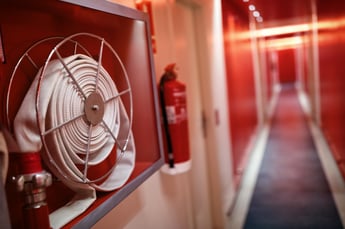
Fire safety isn’t a one-size-fits-all. Different systems work in different building environments. Preparing your business against the threat of fire is one of the most important things you can do. With so many fire safety products and systems out there today, it can be challenging to figure out which will work best for your situation.
Factors to Consider
There are a few factors that are important to consider when choosing the correct fire safety system. First, you need to consider the size and type of structure you’re planning to protect. It’s also important to take inventory of the kind of materials and assets stored inside the structure. These assets could be far more valuable than the building itself making them irreplaceable.
Additionally, operation and maintenance need to be considered. You want a fire safety system that will alert the proper emergency services immediately, so you don’t need to worry about extinguishing the fire and can focus on evacuation.
Once you’ve looked at these factors, you can consider the different categories of systems to determine which provides the best protection for your environment.
Active Fire Safety Systems
Active systems are some of the more common fire safety products you may be familiar with. Fire sprinkler systems, fire extinguishers, smoke and fire alarms are all part of an active fire system. All of these systems require some sort of action to take place in order to activate.
Active systems can be manually activated – e.g. manually pulling a fire alarm pull station – or automatically activated – e.g. a smoke detector sounding an alarm – in the event of a fire. These systems do exactly what they mean – they activate and alert people in the event of an emergency so they can evacuate.
Passive Fire Safety Systems
Passive fire safety products and systems act as a suppressor to the fire and smoke. They extend the evacuation time instead of actively trying to contain or extinguish fires like active fire safety systems.
A few examples of these systems are fire doors, fire dampers, or resistant walls, all of which are used in commercial buildings. When heat or smoke is detected, these systems automatically engage so they can contain the fire to location origin and slow it from spreading creating further damage, or worse.
Many businesses have both active and passive fire safety systems. These systems work together to provide the best protection to the people and assets of the business. But choosing the right fire safety systems goes beyond these two categories. If you need an active fire safety system, you must choose carefully – especially when it comes to fire suppression.
Choosing a Fire Suppression System
There are many types of fire suppression systems. One of the most common types is fire sprinklers. A fire sprinkler system is one of the most popular, well-known methods for slowing the spread of a fire. It is connected to a water supply system and uses water pressure to propel water or a combination of water and foam to the affected areas. There are several different types of water sprinklers available on the market including: pre-action, dry, wet pipe, water mist, and deluge.
Though effective, depending on your type of environment fire sprinklers may do just as much harm to your assets – like computer servers or documents – as the actual fire. In these situations, it’s best to look at special fire safety suppression systems.
Special Fire Safety Suppression Systems
Fire suppression systems are found in areas where it would be difficult to replace assets inside if destroyed. Think museums, data facilities, or even manufacturing and industrial facilities. It is well-known that these sites are considered high-risk, dangerous environments given what’s kept inside (files, equipment, high-end paintings).
Traditional water-based fire suppression systems are often either not up to the task of suppressing fires in these environments, or they risk causing more harm than good. There are several different fire suppression systems, including clean agents, gas systems, and dry chemical.
Clean agents are ideal for a wide range of applications and instances when delicate equipment or assets must be protected. They avoid damage often associated with traditional water sprinkler systems.
Gas suppression systems, such as nitrogen or CO2, uses either high-pressure or low-pressure CO2 to suppress a fire and can protect a large room or a specific piece of equipment. These systems work by displacing oxygen that is present, effectively putting out the fire.
Dry chemical is used for situations that require a special fire suppression response, such as gas stations. These chemicals are designed to extinguish a fire that would otherwise be unstoppable by water sprinklers.
Remember, even though your building is up to code, without the right fire protection systems, you won’t get the best protection and preservation for your people and assets. There is no one-size-fits-all protection system.
Whether your environment consists of expensive machinery, data files, or business desks, all environments are unique. Each risk needs to be addressed individually to ensure you’re using the correct fire safety system and it provides effective protection. The safety of the employees and assets inside the building are what’s most important. Evaluating the right systems for your environment is the difference that takes you beyond compliance, granting true protection.

